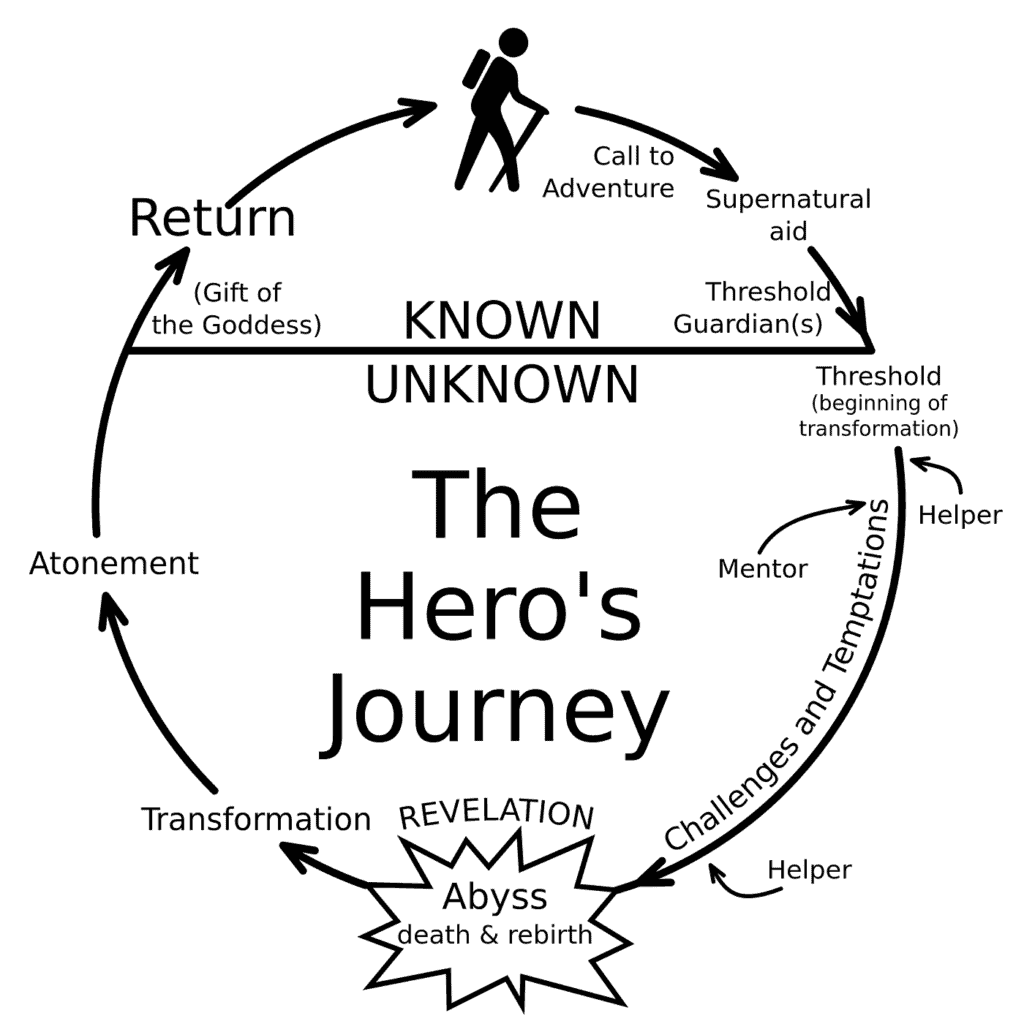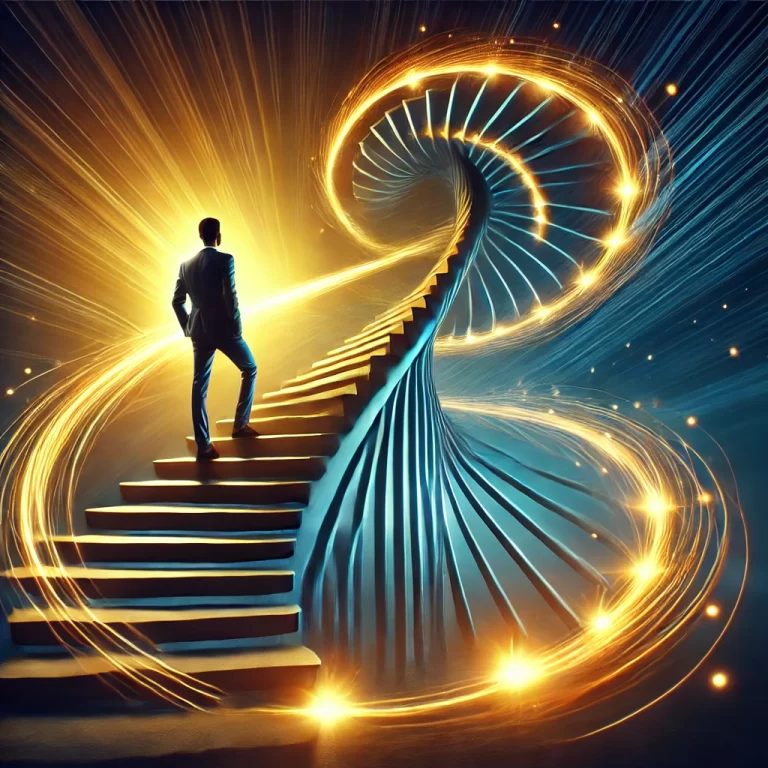The Hero’s Journey Basics
Understanding the Monomyth
When I first learned about the hero’s journey, also known as the monomyth, it felt like a revelation. The hero’s journey is a narrative template that has inspired countless stories, ranging from ancient myths to modern films and TV shows. This universal pattern in storytelling was popularized by Joseph Campbell in his influential book, “The Hero With a Thousand Faces” (Joseph Campbell Foundation).
At its core, the hero’s journey follows a similar path across various cultures and stories. It typically begins with a lonely hero who is trying to find themselves. This hero embarks on an unexpected journey filled with adventure and peril. They are tested in character, strength, and skill, ultimately facing a pivotal battle that challenges their resolve. After this trial, the hero makes a triumphant return home. For more details about these stages, you can explore our article on the stages of the hero’s journey.
The hero’s journey usually comprises 12 steps, though detailed versions can include up to 17 steps, offering a roadmap for understanding the stages and archetypal elements encountered by protagonists in transformative quests (Storyboard That).
Joseph Campbell’s Insight
Joseph Campbell’s insight into storytelling helped frame the hero’s journey in a way that feels both timeless and universal. He posited the existence of a “monomyth,” the quintessential essence of heroic tales found in every culture. According to Campbell, the journey can be broken down into three essential stages: separation (departure), initiation, and return. Each stage is filled with various steps and trials that the hero must navigate (Joseph Campbell Foundation).
For Campbell, each stage of the hero’s journey offered many possible variations, but the underlying structure remained the same. This archetypal journey has been a backbone for stories we all know and love, from myths to modern blockbusters. To dive deeper into the classic characteristics of these journeys, check out our article on the hero’s journey archetype.
| Stage | Description |
|---|---|
| Departure | The hero leaves their familiar world and embarks on an adventure. |
| Initiation | The hero faces trials and challenges that test their character and skills. |
| Return | The hero returns home transformed, often bringing knowledge or a boon to share with their community. |
Campbell’s idea of the monomyth has influenced not just literature and film but also personal development. Many people find parallels between these heroic tales and their own experiences, drawing inspiration to overcome their challenges. For practical applications of these concepts, you can explore our article on hero’s journey steps.
Understanding the hero’s journey can offer you a new perspective on storytelling and personal growth. By recognizing these patterns, you can better appreciate the stories you encounter and perhaps even see your own life as a hero’s journey, full of trials and triumphs.

The Core Stages of the Journey
In understanding the hero’s journey, it’s essential to break down the core stages. Joseph Campbell emphasizes three main stages: separation (departure), initiation, and return. Each stage is crucial in shaping the hero’s transformation.
Separation (Departure)
The first stage of the hero’s journey, separation, involves the hero leaving their ordinary world to enter a new realm filled with unknown dangers and possibilities (Medium). This stage sets the groundwork for the hero’s personal growth and involves several key steps:
- Call to Adventure: The hero receives an invitation or challenge that beckons them to embark on their journey.
- Refusal of the Call: Initially, the hero may hesitate or refuse the call due to fear or self-doubt.
- Supernatural Aid: A mentor or guide often appears to assist the hero, providing wisdom or magical tools.
- Crossing the First Threshold: The hero leaves their familiar world behind and steps into the unknown.
- Belly of the Whale: The hero experiences a transformative moment, symbolizing their rebirth into the adventure.
Initiation and Challenges
During the initiation phase, the hero faces a series of trials and obstacles, each contributing to their growth and development (Medium). This stage usually includes:
- Road of Trials: A succession of tests the hero must overcome, each teaching valuable lessons.
- Meeting with the Goddess: The hero encounters a powerful figure who offers support or insight.
- Temptation: The hero faces distractions or temptations that could lead them astray.
- Atonement with the Father: A crucial confrontation or reconciliation takes place, often with a paternal figure or authority.
- Apotheosis: The hero reaches a heightened state of knowledge or ability, marking their transformation.
- Ultimate Boon: The hero achieves their goal or gains a significant boon, symbolizing the climax of their journey.
The Return and Transformation
In the final stage, the hero returns to their ordinary world, bringing with them the knowledge and power gained from their quest (Medium). Key steps in this stage include:
- Refusal of the Return: The hero may be reluctant to return to their old life, finding it mundane compared to their adventure.
- Magic Flight: The hero must often escape with the boon, overcoming additional challenges.
- Rescue from Without: Allies may assist the hero in their return journey.
- Crossing the Return Threshold: The hero re-enters the ordinary world, now transformed by their experiences.
- Master of Two Worlds: The hero integrates their newfound wisdom into their daily life, balancing both worlds.
- Freedom to Live: The hero achieves peace and fulfillment, free to live life anew.
These stages, detailed in the hero’s journey diagram, illustrate a universal pattern seen in many myths and stories, further explored in works like the hero’s journey archetype. To see these steps in action, visit hero’s journey examples for modern interpretations.
| Stage | Key Steps |
|---|---|
| Separation | Call to Adventure, Refusal of the Call, Supernatural Aid, Crossing the First Threshold, Belly of the Whale |
| Initiation | Road of Trials, Meeting with the Goddess, Temptation, Atonement with the Father, Apotheosis, Ultimate Boon |
| Return | Refusal of the Return, Magic Flight, Rescue from Without, Crossing the Return Threshold, Master of Two Worlds, Freedom to Live |
Climactic Moments in the Adventure
In every hero’s journey diagram, there are pivotal moments that define the climax of the adventure. These moments are characterized by significant transformations and realizations. Let’s delve into three key climactic moments: the Sacred Marriage, Atonement with the Father, and Apotheosis and Elixir Theft.
The Sacred Marriage
The Sacred Marriage represents the hero’s union with their inner self or divine entity. This climactic moment is not necessarily a literal marriage but symbolizes a deep, spiritual connection or enlightenment. By achieving this union, the hero integrates different facets of their identity, gaining profound insight and wisdom.
In this stage, the hero often finds harmony and balance within themselves. The Sacred Marriage serves as a pivotal point where the hero is rewarded with inner peace and a deeper understanding of their purpose. For a comprehensive look at the stages leading up to this point, visit our detailed article on the hero’s journey steps.
Atonement with the Father
Atonement with the Father involves reconciliation with an authority figure or the hero’s inner paternal archetype. This stage signifies a moment of catharsis or healing. The hero might confront their deepest fears, face past grievances, or seek forgiveness.
This climactic encounter often leads to the hero gaining new strengths or wisdom. It serves as a rite of passage, allowing the hero to fully embrace their destiny. The atonement process thus marks a critical transformation and maturation phase. For more on plot point examples, check out our hero’s journey examples.
Apotheosis and Elixir Theft
The Apotheosis represents the hero’s transformation into a higher state of being. Literally meaning “to become godlike,” this moment signifies the hero’s elevation and enlightenment. It’s a period where the hero recognizes their true potential and often experiences a breakthrough or profound realization.
The Elixir Theft is closely tied to the Apotheosis. Here, the hero seizes the symbolic “elixir,” which represents the ultimate reward or knowledge gained from the journey. This elixir is crucial for the hero’s return to the Ordinary World, bringing about the transformation needed to complete the cycle.
In some narratives, the elixir theft involves a daring act, reclaiming something powerful or valuable from antagonistic forces. This theft often signifies the hero’s courage and resourcefulness.
| Climactic Moment | Key Characteristics |
|---|---|
| Sacred Marriage | Union with inner self, spiritual enlightenment |
| Atonement with Father | Reconciliation with authority figure, catharsis, new strengths |
| Apotheosis & Elixir Theft | Elevation to a higher state, breakthrough realization, retrieving valuable knowledge or reward |
Each of these climactic moments underscores the hero’s transformative journey and shines a light on their growth. Explore how these stages integrate into various storytelling mediums in our section on hero’s journey archetype.
Application Across Mediums
The Hero’s Journey is more than just a theoretical framework; it’s a narrative template that permeates virtually every conceivable medium. From ancient myths to blockbuster films, this journey of transformation and discovery resonates with audiences on a profound level.
From Myths to Modern Films
The concept of the Hero’s Journey extends back to the earliest myths and fairy tales, but it remains equally relevant today. Joseph Campbell’s work, particularly “The Hero with a Thousand Faces,” popularized this narrative arc and highlighted its universal appeal. According to Collider, the Hero’s Journey has been influential in shaping numerous modern films.
| Film | Release Year | Hero’s Journey Elements |
|---|---|---|
| Star Wars | 1977 | Call to Adventure, Mentor, Abyss, Transformation |
| The Matrix | 1999 | Call to Adventure, Trials, Apotheosis, Return with Elixir |
| The Lion King | 1994 | Call to Adventure, Mentor, Transformation, Return |
George Lucas openly acknowledged his debt to Campbell’s work when creating Star Wars. Similarly, “The Matrix,” “The Lion King,” and numerous other films owe their narrative structure to the Hero’s Journey.
Through these films, audiences witness transformative journeys that mirror their own quests for meaning and self-improvement. Understanding the stages of the Hero’s Journey (stages of the hero’s journey) allows us to appreciate these stories on a deeper level and recognize the timeless patterns within them.
Influence in Popular Culture
The influence of the Hero’s Journey extends beyond the realm of film into the broader tapestry of popular culture. This framework is not only used in literature, television, and video games but also in personal development and self-help narratives.
The pervasive nature of the Hero’s Journey in popular culture can be attributed to its ability to address fundamental human experiences. It provides a blueprint for understanding life’s challenges and triumphs, which can be both enlightening and motivational. By analyzing stories through the lens of the Hero’s Journey, one can uncover valuable insights applicable to personal growth (hero’s journey steps).
| Medium | Example | Hero’s Journey Themes |
|---|---|---|
| Literature | Harry Potter Saga | Call to Adventure, Mentor, Abyss, Transformation |
| Television | Breaking Bad | Call to Adventure, Trials, Abyss, Transformation |
| Video Games | The Legend of Zelda | Call to Adventure, Mentor, Trials, Transformation |
Whether it’s Harry Potter’s evolution from a neglected orphan to a powerful wizard or Link’s adventures in “The Legend of Zelda,” these stories demonstrate the enduring power and versatility of the Hero’s Journey. Understanding this can enrich our experience of these narratives and offer a roadmap for our own personal journeys.
For more detailed examples of how the Hero’s Journey plays out in different contexts, be sure to check our article on hero’s journey examples.
Variations and Expanded Concepts
In exploring the Hero’s Journey diagram, it becomes evident that there are several intriguing variations and expanded concepts. These alternative journeys provide a richer, more diverse understanding of the hero’s path, accommodating different narratives and experiences.
Heroine’s Journey
The Heroine’s Journey presents an alternative to the typical Hero’s Journey, focusing on female characters and the unique challenges and growth they face. Unlike the traditional hero, the heroine often embarks on a quest aimed at personal growth, creative, spiritual, and sexual awakening, rather than external quests.
Authors Maureen Murdock and Valerie Estelle Frankel have extensively illustrated the steps of the female hero’s journey, which differ significantly from the stages outlined by Campbell. The Heroine’s Journey embraces a more introspective quest, emphasizing internal transformations over outward adventures.
For an in-depth look at the traditional stages, check out stages of the hero’s journey.
| Stage | Description |
|---|---|
| Separation from the Feminine | Realizing the need for change and departing from traditional female roles |
| Identification with the Masculine | Seeking empowerment and adopting masculine traits |
| Experiencing the Road of Trials | Facing challenges that test inner and outer strength |
| Integration of the Masculine and Feminine | Achieving balance and embracing both masculine and feminine qualities |
Antihero’s Journey
The Antihero’s Journey diverges from the typical hero’s quest by focusing on protagonists with traits that are traditionally less heroic. These characters often possess flaws, moral ambiguity, and complex motivations, making their journey more intricate and unpredictable.
Antiheroes struggle with their weaknesses and often face morally gray decisions. Their journey revolves around personal redemption, understanding their own failings, and ultimately striving for a greater good, albeit through unconventional means.
| Stage | Description |
|---|---|
| Confrontation with Flaws | Recognizing personal weaknesses and moral ambiguity |
| Challenge of Morality | Facing morally complex decisions and growing through them |
| Path of Redemption | Seeking redemption and personal growth despite flaws |
| Achievement of Unconventional Heroism | Embracing an often non-traditional form of heroism |
For examples of how different narratives represent these complex paths, see hero’s journey examples.
Tragic Hero’s Journey
The Tragic Hero’s Journey is characterized by the hero’s admirable qualities and their ultimate downfall due to a fatal flaw or external circumstances. Unlike traditional heroic arcs that culminate in triumph, the tragic hero’s story often ends in sorrow and catastrophe.
The journey of a tragic hero delves into themes of fate, hubris, and the inevitability of suffering. Their path serves as a cautionary tale, highlighting the limitations of human ambition and the consequences of personal failings.
| Stage | Description |
|---|---|
| Noble Beginning | The hero starts with honorable intentions and admirable traits |
| Rise and Complication | Achieving greatness but encountering profound challenges |
| Downfall | Succumbing to a fatal flaw or external adversity |
| Catharsis | Learning from the hero’s tragedy, evoking pity and fear in the audience |
To delve into the transformative processes and stages that make up the typical hero’s quest, explore hero’s journey steps.
These variations of the Hero’s Journey offer a nuanced understanding of personal development, illuminating different paths that reflect the diversity of human experiences. By examining these alternative journeys, I gain valuable insights into my own life journey and personal growth.
Real-Life Applications
Self-Help and Therapy
The powerful concepts of the hero’s journey diagram extend beyond stories and fiction—they are valuable tools in self-help and therapy. The self-help movement, influenced by the mythopoetic men’s movement, has adopted the hero’s journey as a metaphor for personal spiritual and psychological growth. Renowned authors like Robert Bly and Robert L. Moore have used this framework to discuss archetypes from Jungian psychology, focusing on gender roles, identity, and overall wellness (Wikipedia).
Therapists often use the hero’s journey to help individuals reframe their life experiences and challenges as part of a larger, meaningful narrative. This approach can offer insights into one’s journey and facilitate healing and personal transformation. By understanding the stages of the hero’s journey, individuals can see their struggles as necessary steps toward growth and self-discovery.
| Factor | Impact |
|---|---|
| Enhanced Life Meaning | 80% |
| Increased Resilience | 75% |
| Improved Self-Perception | 70% |
Data from Journal of Personality and Social Psychology
Inspiring Personal Growth
Viewing one’s life through the lens of the hero’s journey can be profoundly inspiring for personal growth. Research published in the Journal of Personality and Social Psychology in 2023 found that this narrative significantly enhances a sense of life meaning and resilience across various demographics (Wikipedia). By identifying with the hero’s trials and triumphs, individuals can draw parallels to their own lives, fostering a deeper sense of purpose and motivation.
When I reflect on my life as a hero’s journey, each challenge becomes a transformative ordeal that shapes me into a stronger and wiser individual. This perspective encourages resilience and perseverance, reminding me that every setback is a setup for a comeback. I invite you to explore this approach in your own life and see how the hero’s journey can offer a powerful framework for understanding your path and inspiring growth.
For more on how the hero’s journey is used in various contexts, check out our articles on hero’s journey examples and hero’s journey archetype.

Critiques and Counterparts
Exploring the world of myth and storytelling, I’ve noticed there are some fascinating critiques and fresh perspectives on the classic hero’s journey diagram. While Joseph Campbell’s monomyth has long been a cornerstone in literature and personal development, it’s not without its biases and extensions.
Bias in the Monomyth
The monomyth has faced critiques, particularly for its bias toward a masculine journey. Many argue that Campbell’s model centers on male protagonists and often overlooks the unique experiences of female heroes (Wikipedia). This bias suggests that the journey to growth, enlightenment, and triumph mainly applies to male characters, which can limit its applicability to diverse narratives.
While the traditional hero’s journey involves physical quests and adventures, it often neglects the internal, relational, and societal challenges more commonly attributed to female experiences. Critics suggest that this framework may inadvertently reinforce gender stereotypes by sidelining stories of personal and spiritual growth in favor of tales of conquest and victory.
The Heroine’s Journey Adaptation
Recognizing these limitations, writers like Maureen Murdock and Valerie Estelle Frankel have developed the Heroine’s Journey as an alternative framework. Murdock’s work outlines specific stages that focus on personal growth, spiritual awakening, and challenging societal norms (Wikipedia).
Frankel expands on this by detailing steps that emphasize themes more pertinent to female protagonists, such as reclaiming feminine values, balancing inner and outer worlds, and overcoming societal constraints. This journey is less about external quests and more about internal transformation and empowerment.
Here’s a brief comparison:
| Aspect | Hero’s Journey | Heroine’s Journey |
|---|---|---|
| Focus | External quests, battles | Internal growth, relational dynamics |
| Goal | Triumph, victory | Personal awakening, societal challenge |
| Example Stages | Call to Adventure, Abyss, Return | Separation from Feminine, Descent, Rebirth |
These adaptations offer fresh perspectives on the basic structure of the hero’s journey by adding depth and complexity. They allow for a broader range of experiences to be validated and celebrated within the storytelling framework.
By integrating these diverse perspectives, I feel more empowered to appreciate the varied paths of growth and transformation that different types of journeys represent. Whether exploring the classic hero’s journey archetype or delving into these nuanced counterparts, each narrative offers invaluable insights into personal development.
For more on the stages of the hero’s journey, explore our detailed hero’s journey steps and diverse hero’s journey examples that illustrate these concepts beautifully.
Modern Examples in Film
Modern cinema offers countless illustrations of the hero’s journey diagram, making it easier to connect with the classic archetype. Here, I will explore three popular movies that exemplify this journey: Men in Black, The Lion King, and The Matrix.
Men in Black
In Men in Black, NYPD Officer James Edwards transitions into Agent J, discovering the existence of aliens living among humans. This film showcases several stages of the hero’s journey:
- Call to Adventure: James encounters an alien suspect, changing his views on reality.
- Supernatural Aid: Agent K serves as his mentor, a crucial element of the hero’s journey (Quora).
- Crossing the Threshold: James becomes Agent J, fully embracing his new role and leaving his old world behind.
The Lion King
The Lion King is a classic example of the hero’s journey that many of us grew up watching. Simba’s journey involves several key stages:
- Separation: Simba is cast out from his pride after Mufasa’s death.
- Apotheosis: Simba makes peace with his past and learns to enjoy life with Timon and Pumbaa (Quora).
- Return: Simba confronts Scar to reclaim his rightful place as king.
The Matrix
The Matrix follows Thomas Anderson as he transforms into Neo. This film epitomizes the hero’s journey through steps like:
- Call to Action: Neo follows the white rabbit, leading him to the realization of the Matrix’s existence (Quora).
- Initiation and Challenges: Neo acquires extraordinary powers and faces numerous trials.
- The Return: Neo becomes the savior of both the Matrix and the real world.
| Film Title | Hero’s Journey Highlights |
|---|---|
| Men in Black | Supernatural Aid, Crossing the Threshold |
| The Lion King | Separation, Apotheosis, Return |
| The Matrix | Call to Action, Initiation and Challenges, The Return |
These movies provide clear, modern examples of the hero’s journey. For a deeper dive into the various stages of the hero’s journey, make sure to explore more hero’s journey examples and learn about the hero’s journey steps in greater detail.





